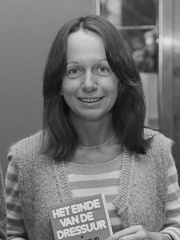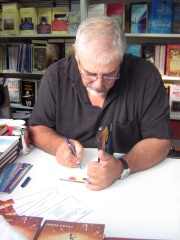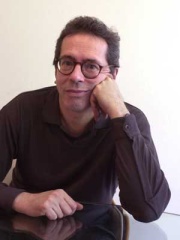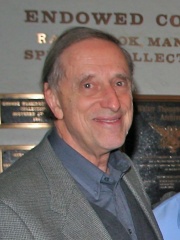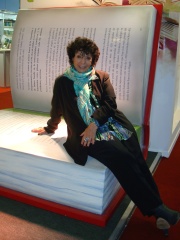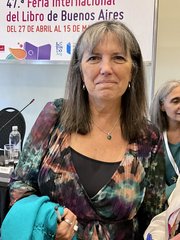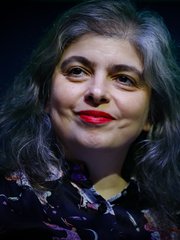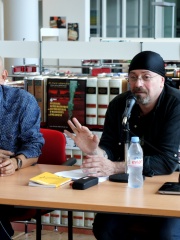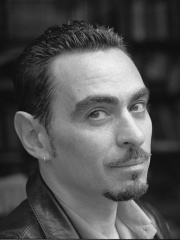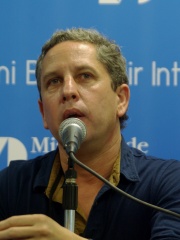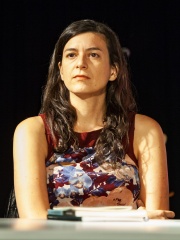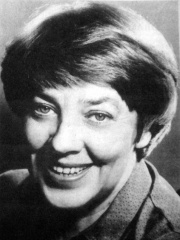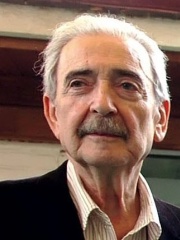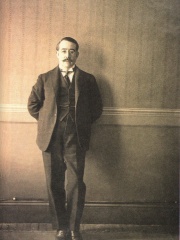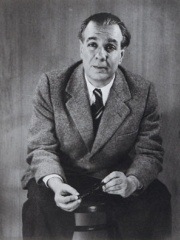
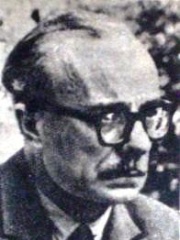
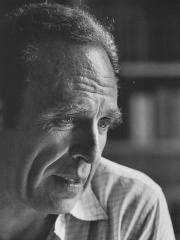
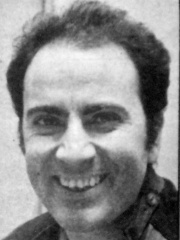
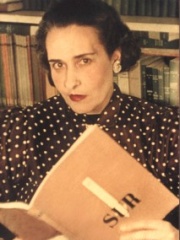
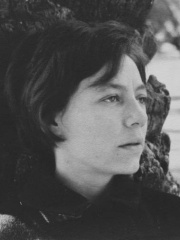
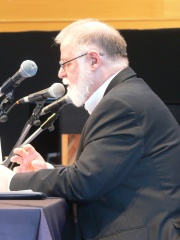
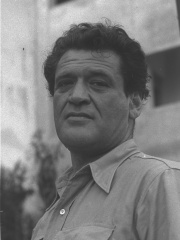
The Most Famous
WRITERS from Argentina
Top 10
The following people are considered by Pantheon to be the top 10 most legendary Argentinean Writers of all time. This list of famous Argentinean Writers is sorted by HPI (Historical Popularity Index), a metric that aggregates information on a biography's online popularity. Visit the rankings page to view the entire list of Argentinean Writers.

1. Jorge Luis Borges (1899 - 1986)
With an HPI of 83.40, Jorge Luis Borges is the most famous Argentinean Writer. His biography has been translated into 144 different languages on wikipedia.
Jorge Francisco Isidoro Luis Borges ( BOR-hess; Spanish: [ˈxoɾxe ˈlwis ˈboɾxes] ; 24 August 1899 – 14 June 1986) was an Argentine short-story writer, essayist, poet and translator regarded as a key figure in Spanish-language and international literature. His best-known works, Ficciones (transl. Fictions) and El Aleph (transl. The Aleph), published in the 1940s, are collections of short stories exploring motifs such as dreams, labyrinths, chance, infinity, archives, mirrors, fictional writers, and mythology. Borges's works have contributed to philosophical literature and the fantasy genre, and have had a major influence on the magical realist movement in 20th century Latin American literature. Born in Buenos Aires, Borges later moved with his family to Switzerland in 1914, where he studied at the Collège de Genève. The family travelled widely in Europe, including Spain. On his return to Argentina in 1921, Borges began publishing his poems and essays in surrealist literary journals. He also worked as a librarian and public lecturer. In 1955, he was appointed director of the National Public Library and professor of English Literature at the University of Buenos Aires. He was completely blind by the age of 55. Scholars have proposed that his progressive loss of sight influenced his development of innovative literary symbols through imaginative techniques. By the 1960s, his work was translated and published widely in the United States and Europe. Borges himself was fluent in several languages. In 1961, Borges came to international attention when he received the first International Formentor Prize, which he shared with Samuel Beckett. In 1971, he won the Jerusalem Prize. His international reputation was consolidated in the 1960s, aided by the growing number of English translations, the Latin American Boom, and by the success of García Márquez's One Hundred Years of Solitude. He dedicated his final work, The Conspirators, to the city of Geneva, Switzerland. Writer and essayist J. M. Coetzee said of him: "He, more than anyone, renovated the language of fiction and thus opened the way to a remarkable generation of Spanish-American novelists." David Foster Wallace wrote: "The truth, briefly stated, is that Borges is arguably the great bridge between modernism and post-modernism in world literature ... His stories are inbent and hermetic, with the oblique terror of a game whose rules are unknown and its stakes everything."

2. Ernesto Sabato (1911 - 2011)
With an HPI of 68.46, Ernesto Sabato is the 2nd most famous Argentinean Writer. His biography has been translated into 54 different languages.
Ernesto Sabato (Spanish: [ˈsaβaðo]; June 24, 1911 – April 30, 2011) was an Argentine novelist, essayist, painter, and physicist. According to the BBC he "won some of the most prestigious prizes in Hispanic literature" and "became very influential in the literary world throughout Latin America". Upon his death El País dubbed him the "last classic writer in Argentine literature". Sabato was distinguished by his bald pate and brush moustache and wore tinted spectacles and open-necked shirts. He was born in Rojas, a small town in Buenos Aires Province. Sabato began his studies at the Colegio Nacional de La Plata. He then studied physics at the Universidad Nacional de La Plata, where he earned a PhD. He then attended the Sorbonne in Paris and worked at the Curie Institute. After World War II, he lost interest in science and started writing. Sabato's oeuvre includes three novels: El Túnel (1948), Sobre héroes y tumbas (1961) and Abaddón el exterminador (1974). The first of these received critical acclaim upon its publication from, among others, fellow writers Albert Camus and Thomas Mann. The second is regarded as his masterpiece, though he nearly burnt it like many of his other works. Sabato's essays cover topics as diverse as metaphysics, politics and tango. His writings led him to receive many international prizes, including the Miguel de Cervantes Prize (Spain), the Legion of Honour (France), the Jerusalem Prize (Israel), and the Prix du Meilleur Livre Étranger (France). At the request of President Raúl Alfonsín, he presided over the CONADEP Commission that investigated the fate of those who suffered forced disappearance during the Dirty War of the 1970s. The result of these findings was published in 1984, bearing the title Nunca Más (Never Again).

3. Adolfo Bioy Casares (1914 - 1999)
With an HPI of 66.94, Adolfo Bioy Casares is the 3rd most famous Argentinean Writer. His biography has been translated into 41 different languages.
Adolfo Bioy Casares (Spanish pronunciation: [aˈðolfo ˈβjoj kaˈsaɾes]; 15 September 1914 – 8 March 1999) was an Argentine fiction writer, journalist, diarist, and translator. He was a friend and frequent collaborator of his fellow countryman Jorge Luis Borges. He is the author of the Fantastique novel The Invention of Morel.

4. Manuel Puig (1932 - 1990)
With an HPI of 65.04, Manuel Puig is the 4th most famous Argentinean Writer. His biography has been translated into 35 different languages.
Juan Manuel Puig Delledonne (December 28, 1932 – July 22, 1990), commonly called Manuel Puig, was an Argentine author and LGBTQ activist. Among his best-known novels are La traición de Rita Hayworth (Betrayed by Rita Hayworth, 1968), Boquitas pintadas (Heartbreak Tango, 1969), and El beso de la mujer araña (Kiss of the Spider Woman, 1976) which was adapted into the film released in 1985, directed by the Argentine-Brazilian director Héctor Babenco; and a Broadway musical in 1993.
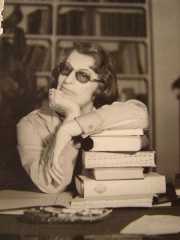
5. Silvina Ocampo (1903 - 1993)
With an HPI of 64.12, Silvina Ocampo is the 5th most famous Argentinean Writer. Her biography has been translated into 32 different languages.
Silvina Ocampo (28 July 1903 – 14 December 1993) was an Argentine short story writer, poet, and artist. Ocampo's friend and collaborator Jorge Luis Borges called Ocampo "one of the greatest poets in the Spanish language, whether on this side of the ocean or on the other." Her first book was Viaje olvidado (1937), translated as Forgotten Journey (2019), and her final piece was Las repeticiones, published posthumously in 2006. Before establishing herself as a writer, Ocampo was a visual artist. She studied painting and drawing in Paris where she met, in 1920, Fernand Léger and Giorgio de Chirico, forerunners of surrealism. She received, among other awards, the Municipal Prize for Literature in 1954 and the National Poetry Prize in 1962.

6. Victoria Ocampo (1890 - 1979)
With an HPI of 63.50, Victoria Ocampo is the 6th most famous Argentinean Writer. Her biography has been translated into 32 different languages.
Ramona Victoria Epifanía Rufina Ocampo (7 April 1890 – 27 January 1979) was an Argentine writer and intellectual. Best known as an advocate for others and as publisher of the literary magazine Sur, she was also a writer and critic in her own right and one of the most prominent South American women of her time. Her sister was Silvina Ocampo, also a writer. She was nominated for the Nobel Prize in Literature on 1970 and 1974.

7. Alejandra Pizarnik (1936 - 1972)
With an HPI of 63.31, Alejandra Pizarnik is the 7th most famous Argentinean Writer. Her biography has been translated into 37 different languages.
Flora Alejandra Pizarnik (29 April 1936 – 25 September 1972) was an Argentine poet. Her idiosyncratic and thematically introspective poetry has been considered "one of the most unusual bodies of work in Latin American literature", and has been recognized and celebrated for its fixation on "the limitation of language, silence, the body, night, the nature of intimacy, madness, [and] death". Pizarnik studied philosophy at the University of Buenos Aires and worked as a writer and a literary critic for several publishers and magazines. She lived in Paris between 1960 and 1964, where she translated authors such as Antonin Artaud, Henri Michaux, Aimé Césaire and Yves Bonnefoy. She also studied history of religion and French literature at the Sorbonne. Back in Buenos Aires, Pizarnik published three of her major works: Works and Nights, Extracting the Stone of Madness, and The Musical Hell as well as a prose work titled The Bloody Countess. In 1969 she received a Guggenheim Fellowship and later, in 1971, a Fulbright Fellowship. On 25 September 1972, she died by suicide after ingesting an overdose of secobarbital. Her work has influenced generations of authors in Latin America.

8. Alberto Manguel (b. 1948)
With an HPI of 62.77, Alberto Manguel is the 8th most famous Argentinean Writer. His biography has been translated into 21 different languages.
Alberto Manguel (born March 13, 1948, in Buenos Aires) is an Argentine-Canadian anthologist, translator, essayist, novelist, editor, and a former director of the National Library of Argentina. He is a cosmopolitan and polyglot scholar, speaking English, Spanish, German, and French fluently, and also Italian and Portuguese at a very advanced level. He left Argentina at the age of twenty, in 1968. He has lived in Israel (Tel Aviv, 1948-1955), Argentina (Buenos Aires, 1955-1968), France (Paris, 1968-1971, and Poitou-Charentes, 2000-2015), United Kingdom (London, 1972), Italy (Milan, 1974-1979), French Polynesia (Tahiti, 1973-1974), Canada (Toronto, 1980-2000), United States (New York; 2015-2020) and Portugal (Lisbon, since 2021). Since 2021 he has directed an international center for reading studies in Lisbon, baptized in 2023 as Espaço Atlântida; In the biography of the center's website you can read: "He became a Canadian citizen and continues to identify his nationality as first and foremost Canadian." He is the author of numerous non-fiction books such as The Dictionary of Imaginary Places (co-written with Gianni Guadalupi in 1980), A History of Reading (1996), The Library at Night (2007) and Homer's Iliad and Odyssey: A Biography (2008); and novels such as News From a Foreign Country Came (1991). Though almost all of Manguel's books were written in English, two of his novels (El regreso and Todos los hombres son mentirosos) were written in Spanish, and El regreso has not yet been published in English. Manguel has also written film criticism such as Bride of Frankenstein (1997) and collections of essays such as Into the Looking Glass Wood (1998). In 2007, Manguel was selected to be that year's annual lecturer for the prestigious Massey Lectures. in 2021, he gave the Roger Lancelyn Green lecture to the Lewis Carroll Society on his love of the 'Alice' stories from Lewis Carroll. For more than twenty years, Manguel has edited a number of literary anthologies on a variety of themes or genres ranging from erotica and gay stories to fantastic literature and mysteries.

9. Joseph Kessel (1898 - 1979)
With an HPI of 62.52, Joseph Kessel is the 9th most famous Argentinean Writer. His biography has been translated into 27 different languages.
Joseph Kessel (10 February 1898 – 23 July 1979), also known as "Jef", was a French journalist and novelist. He was a member of the Académie française and Grand Officer of the Legion of Honour.
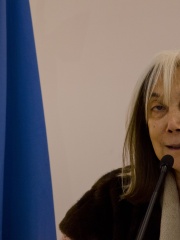
10. María Kodama (1937 - 2023)
With an HPI of 61.68, María Kodama is the 10th most famous Argentinean Writer. Her biography has been translated into 26 different languages.
María Kodama Schweizer (10 March 1937 – 26 March 2023) was an Argentine writer and translator. The widow of author Jorge Luis Borges, she was the sole owner of his estate after his death in 1986. Borges had bequeathed to Kodama his rights as author in a will written in 1979, when she was his literary secretary, and bequeathed to her his whole estate in 1985. They were married in 1986, shortly before Borges' death.
People
Pantheon has 40 people classified as Argentinean writers born between 1805 and 1978. Of these 40, 14 (35.00%) of them are still alive today. The most famous living Argentinean writers include Alberto Manguel, Esther Vilar, and Jorge Bucay. The most famous deceased Argentinean writers include Jorge Luis Borges, Ernesto Sabato, and Adolfo Bioy Casares. As of April 2024, 3 new Argentinean writers have been added to Pantheon including Claudia Piñeiro, Mariana Enríquez, and Nicolás Giacobone.
Living Argentinean Writers
Go to all RankingsAlberto Manguel
1948 - Present
HPI: 62.77
Esther Vilar
1935 - Present
HPI: 61.64
Jorge Bucay
1949 - Present
HPI: 59.78
César Aira
1949 - Present
HPI: 58.56
Ariel Dorfman
1942 - Present
HPI: 55.99
Luisa Valenzuela
1938 - Present
HPI: 52.57
Claudia Piñeiro
1960 - Present
HPI: 49.94
Mariana Enríquez
1973 - Present
HPI: 49.87
Carlos Salem
1959 - Present
HPI: 48.13
Federico Andahazi
1963 - Present
HPI: 47.71
Guillermo Martínez
1962 - Present
HPI: 46.23
Samanta Schweblin
1978 - Present
HPI: 45.80
Deceased Argentinean Writers
Go to all RankingsJorge Luis Borges
1899 - 1986
HPI: 83.40
Ernesto Sabato
1911 - 2011
HPI: 68.46
Adolfo Bioy Casares
1914 - 1999
HPI: 66.94
Manuel Puig
1932 - 1990
HPI: 65.04
Silvina Ocampo
1903 - 1993
HPI: 64.12
Victoria Ocampo
1890 - 1979
HPI: 63.50
Alejandra Pizarnik
1936 - 1972
HPI: 63.31
Joseph Kessel
1898 - 1979
HPI: 62.52
María Kodama
1937 - 2023
HPI: 61.68
María Elena Walsh
1930 - 2011
HPI: 61.25
Juan Gelman
1930 - 2014
HPI: 60.62
Leopoldo Lugones
1874 - 1938
HPI: 59.63
Newly Added Argentinean Writers (2025)
Go to all RankingsClaudia Piñeiro
1960 - Present
HPI: 49.94
Mariana Enríquez
1973 - Present
HPI: 49.87
Nicolás Giacobone
HPI: 41.71
Overlapping Lives
Which Writers were alive at the same time? This visualization shows the lifespans of the 25 most globally memorable Writers since 1700.

